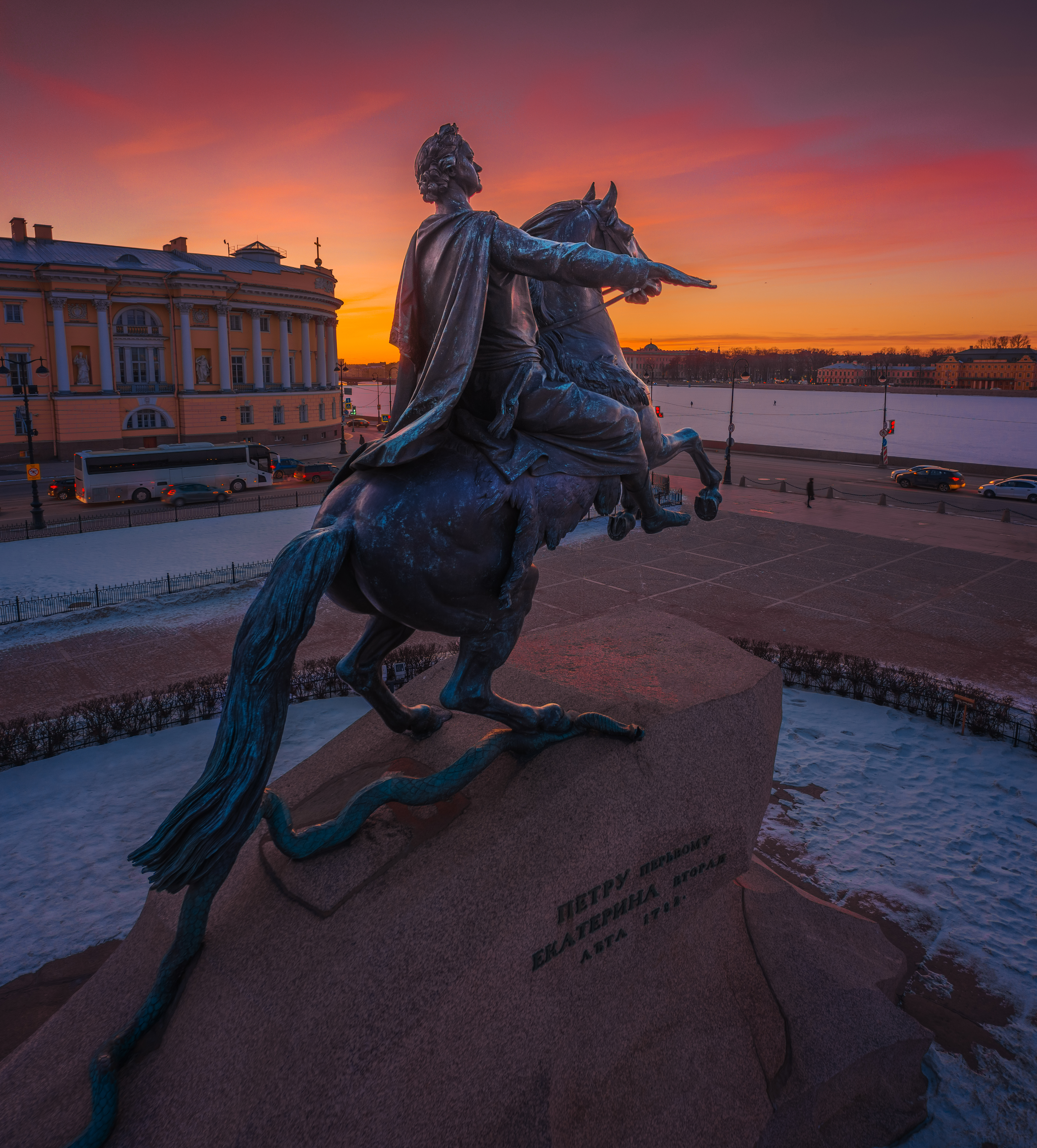 Back
Back
Senate Square

Senatskaya pl.
One of the oldest squares in St. Petersburg
Senate Square started to take shape in 1704, initially as part of the Admiralty’s glacis. The Admiralty was intended not only as a shipyard, but also as a fortress, therefore, it required open space around it. In the mid-1710s, the western border of this space was marked by the tenement house of Prince Menshikov, located on the corner of the Angliskaya Embankment.
Here, on the banks of the Neva, the first wooden building of St. Isaac's Church was put up in 1710 to be used by the admiralty ministers and sailors. Peter I and Catherine I got married in that church.
Since 1717, the southern border of the future Senate Square was washed by the Admiralteysky Kanal, which at first was used to store the construction forest, and then to transport the logs from the New Holland Island. In 1720, another short canal was dug from it, perpendicular to the Neva, emphasizing the western border of the square where the turpentine distillery was located. The Synod building was later erected in its place. This Admiralty Canal’s sublateral contributed to fire safety, since the turpentine distillery posed a threat to the shipyard.
On June 30, 1720, Peter I ordered: “To make a spinning-house behind the courtyard of His Serene Highness and split off the street from that courtyard”. Thus was determined both the place for the Ropeyard, located by the Admiralteysky Canal, and the direction of Galernaya Street extending away from the square.
Since 1727, a floating pontoon Isaakievsky bridge was thrown from here to the opposite bank of the Neva.
In the 1730s, a large stone temple was built on the site of the wooden St. Isaac's Church. It was located approximately where you can now see the monument to Peter I (the famous "Bronze Horseman"). It is noteworthy that the church not only was named after the saint on whose day the founder of St. Petersburg was born, but its first location also coincided with the site of the monument to Peter I. The first official name of this square – Isaakievskaya (St. Isaac's square) - is associated with the cathedral. This name was assigned to the square on April 20, 1738. At that time, the name was written with one letter "a" - "Isakievskaya". The toponym did not catch on; it was used only in the official documents. Later, the name transferred to the area south of the modern St. Isaac's Cathedral.
After the death of Prince Menshikov, his plot of land was given to Vice-Chancellor A. Osterman, and in 1744 - to Chancellor A.P. Bestuzhev-Ryumin. A palace with a baroque facade was built here for the new owner. After Catherine II ascended to the throne, the Senate moved here from the Twelve Colleges building. Under Catherine II, in 1760, St. Isaac's Cathedral changed its location. The foundation of the church on the banks of the Neva was not stable, therefore it had to be moved away from the river. It was at that time that the cathedral was built on the banks of the Admiralty Canal, south of the square.
In 1782, a monument to Peter I (The Bronze Horseman) by the French sculptor E.M. Falconet was unveiled on the square. After this event, the square received a new name - Petrovskaya Square.
At the end of the 18th century, the house of Ustevs merchants appeared on the site of the old turpentine distillery. The house later went over to the merchants Kusovnikovs.
A part of the Admiralty Canal, adjacent to Senate Square, was enclosed in a pipe at the very beginning of the 19th century. The search for the contractors for this work was carried out in the summer of 1804. At the same time, the sublateral that joined the canal with the Neva was filled in.
In 1820, a granite abutment was built at the entrance of St. Isaac's Bridge.
The eastern part of Senate Square was finally fully developed in the 1820s due to the construction of the new Admiralty building by architect Andreyan Zakharov. In 1834, the construction of the magnificent Senate and Synod building, designed by Carlo Rossi, was completed.
On December 14, 1825, the regiments that refused to give an oath to the new Tsar Nicholas I, lined up at the foot of the monument to Peter I. In total, there were about 3,000 rebels on the square, who were surrounded by troops that had already given their oath. The uprising was crushed. These events took place in front of the fourth St. Isaac's Cathedral which was being constructed by architect Auguste Montferrand; it was completed by 1858. Since then, the architectural appearance of the Senate Square has not changed.
In 1874, Senate Square became part of the Alexander Garden arranged by the Admiralty. Flowerbeds and lawns were laid out and scrubby trees were planted near the monument to Peter I. Oaks were planted from the side of St. Isaac's Cathedral. The rockwork was arranged between the monument and the Admiralty. In 1890, the part of the garden near the Bronze Horseman was transformed into a square and cobbled again.
On the occasion of the 100th anniversary of the Decembrist uprising in 1925, the square received a new name - Decembrists Square. On July 31, 2008 its former name – Senate Square – was restored.




 Listen
Listen  Download
Download